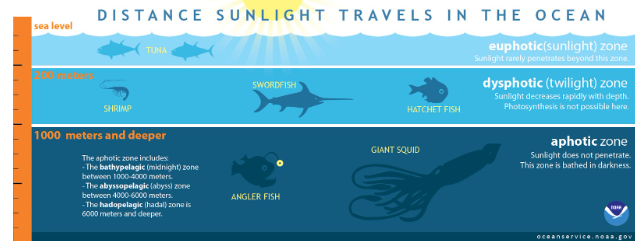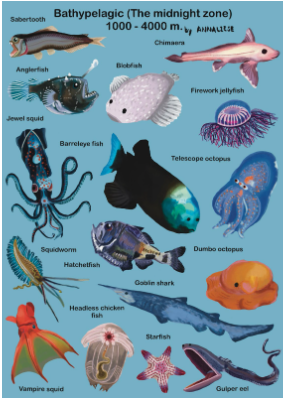
The giant squid (commonly known for their huge bodies, and being in many stories such as Kraken attacks) can grow up to lengths of 41 feet and eat small whales as well as other squid. This species lives in an area called the Midnight Zone, which is located around 9,000-13,000 feet below our oceans, and inhabits odd and alien-like creatures.
The scientific name for this zone is the Bathypelagic Zone, bathy meaning depth, and pelagic meaning open waters. This name is fitting because the Midnight zone is so far deep in the ocean, that there is no light or plants that exist within it. Along with its dark barren waters, if humans were to travel there would be around 5,800 pounds of pressure per square inch. In other words, it would completely crush a human. To add onto that, the temperature in these conditions is 39 degrees fahrenheit which is just 7 degrees above freezing.
So how can animals live in these harsh environments? For starters, to withstand the pressure these fish have less bone structure, and typically have more jelly-like bodies to avoid being crushed. Along with this, these animals do not have swim bladders or lungs, which also help them live under high pressures. By not having gas-filled areas in their bodies, the animals avoid them collapsing. One animal that hunts giant squid is the sperm whale, however this species does not live in the midnight zone. By collapsing their lungs before diving, they are able to dive in the midnight zone to hunt their prey.

As far as exploring this zone goes researchers have only seen one-millionth of it using remote robots. The midnight zone takes up around 70% of the entire ocean, and researchers have only seen a small glimpse of it. Within this small glimpse there have been a reported 167 species of animals who have been able to adapt to live in those harsh environments.
From what we know, the ocean takes up 70% of Earth and only 5% of it has been explored. On top of that, as stated above the midnight zone takes up 70% of the whole ocean, and only one-millionth of the midnight zone has been studied and researched. For this reason, people may argue that we need to explore our oceans, below our surface lies another world that humans do not have the chance to explore just yet, and the midnight zone proves that.
References:
Finding resilience—and relaxation—in the midnight zone
annualreport.mbari.org
Midnight Zone
www.whoi.edu
Do deep-sea fishes have low-density bones?
wp.geneseo.edu
Midnight Zone (2)
www.oceanscape-aquarium.org